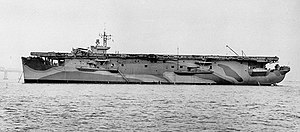Attacker-class escort carrier

HMS Attacker
|
|
| Class overview | |
|---|---|
| Name: | Attacker class |
| Builders: |
|
| Operators: | Royal Navy |
| Preceded by: | Avenger class |
| Succeeded by: | Ruler class |
| Built: | 1941–1943 |
| In commission: | 1942–1946 |
| Planned: | 8 |
| Completed: | 8 |
| Retired: | 5 |
| Scrapped: | 3 |
| General characteristics | |
| Type: | Escort carrier |
| Displacement: | 11,420 long tons (11,600 t) |
| Length: | 492 ft (150 m) |
| Beam: | 69.5 ft 6 in (21.34 m) |
| Draught: | 23.25 m (76.3 ft) |
| Installed power: | 9,350 shp (6,970 kW) |
| Propulsion: |
|
| Speed: | 17 knots (31 km/h; 20 mph) |
| Complement: | 646 |
| Armament: |
|
| Aircraft carried: | 24 |
| Aviation facilities: |
|
Attacker-class escort carriers were a type of aircraft carrier in service with the British Royal Navy during the Second World War. There were eight ships in the class, all constructed in the United States and supplied under the terms of Lend-Lease to the Royal Navy.
The ships served in two different roles: as convoy escort carriers, equipped with both anti-submarine and fighter aircraft, and as strike carriers, equipped with just fighter aircraft. When used as convoy escorts, the ships' aircraft were successful in deterring German submarines from attacking Allied convoys, with a number of German submarines and aircraft destroyed or damaged by the aircraft. Those carriers operating in the strike role took part in two major landings in the Mediterranean and an operation against the German battleship Tirpitz in Norwegian waters. Seven of the ships ended the war in the Far East in the campaigns against the Japanese Empire and were then used to transport home prisoners of war.
All eight ships survived the war and were eventually returned to the United States Navy, which sold five of them for conversion into merchant ships. The other three ships were scrapped.
The Attacker class comprised eight ships built in the United States for the Royal Navy during the Second World War. They were all built between 1941 and 1942 by Ingalls Shipbuilding or Western Pipe & Steel shipyards; both companies completed four ships. They were then supplied under the terms of Lend-Lease to the Royal Navy for their use. The ships had a complement of 646 men. Crew accommodations were significantly different from the normal for the Royal Navy at the time. Instead of food being prepared by separate messes, it was cooked in the galley and served cafeteria-style in a central dining area. Unlike British-built ships, they were equipped with a modern laundry and a barber shop. The traditional hammocks were replaced by three-tier bunk beds, 18 to a cabin, which were hinged and could be tied up to provide extra space when not in use.
...
Wikipedia
